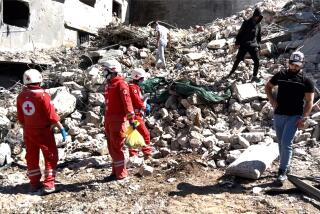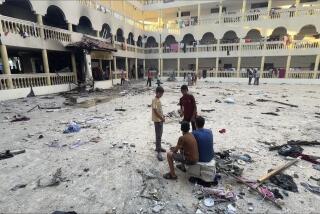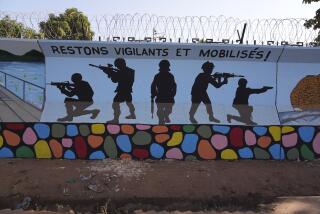40 Killed in U.S. Attack on Iraqi Border Village
- Share via
BAGHDAD — U.S. helicopter gunships and ground troops struck a village in Iraq’s western desert, hitting what Iraqis said was a wedding celebration, but what the U.S. said was a suspected safe house for foreign fighters.
Reports of the number of people killed varied, but Iraqi and U.S. officials estimated that about 40 died in Tuesday’s attack on a hamlet of just 11 houses. The village is 15 miles from the Syrian border and about 50 miles southwest of Husaybah.
For the record:
12:00 a.m. May 21, 2004 For The Record
Los Angeles Times Friday May 21, 2004 Home Edition Main News Part A Page 2 National Desk 0 inches; 26 words Type of Material: Correction
Iraq attack -- An article in Thursday’s Section A about a U.S. raid in western Iraq said the assault took place Tuesday. It occurred early Wednesday.
“We received about 40 martyrs today, mainly women and children below the age of 12,” Hamdy Lousy, the director of a nearby hospital, told Arab satellite channel Al Arabiya. “We also have 11 people wounded, most of them in critical condition.”
In Baghdad, Brig. Gen. Mark Kimmitt, deputy director of operations for the U.S. military in Iraq, said the attack targeted a safe house for suspected foreign fighters.
Asked about reports of dozens killed, he told Reuters: “We are not disputing the numbers you are hearing. We estimate that around 40 were killed. But we operated within our rules of engagement.”
Officials at the State Department and Pentagon said they had no information on the incident.
Senior military officials in Baghdad said they did not believe there was a wedding going on. “Could there have been a party going on? Yes. Do we believe it was a wedding party? Not too many wedding parties have 34 men and six women,” said a senior military official.
The official said they believed up to six women could have been killed but said there were “no ground reports” of any children being killed. “We are investigating,” the official said.
However, Associated Press Television News footage showed a truck containing bloodied bodies, many wrapped in blankets, piled one atop the other. Several were those of children. The body of a girl who appeared to be younger than 5 lay in a white sheet, her legs riddled with wounds and her dress soaked with blood.
Pictures of several shrouded bodies and of men digging graves were shown on Arab television.
According to U.S. Central Command, forces conducted a military operation at 3 a.m. Tuesday.
Senior military sources in Baghdad said buildings were attacked after U.S. forces received “very strong intelligence there was a foreign fighter safe house in the open desert.”
The intelligence before the military attack suggested that it was used to smuggle foreign fighters into Iraq, and items found at the scene confirmed that suspicion, according to the military.
One of the buildings was outfitted like “a hospital” with “a medical room complete with syringes and drugs, bedding,” said the official.
“Clearly, it was consistent with a smugglers camp, but that’s the same rat lines that we talk about for infiltrating foreign fighters into and out of Iraq.” (A rat line is the rope that rodents use to get on or off a ship.)
The military on the ground during the operation came under fire and called in air support.
An investigation is underway.
Iraqis said it was a wedding party that had come under fire from U.S. troops because guests were shooting into the air in celebration.
Such celebratory gunfire is common across the Middle East and Central Asia.
In July 2002, 48 people were killed and 117 were wounded by a U.S. air attack on an Afghan village in Oruzgan province where a wedding was being celebrated. U.S. officials apologized but insisted they had acted properly in response to what they thought was hostile fire.
In a statement released late Wednesday after questions from the media, the military said it had conducted an “operation against a suspected foreign fighter safe house in the open desert. During the operation, coalition forces came under hostile fire and close air support was provided.
“Coalition forces on the ground recovered numerous weapons, 2 million Iraqi and Syrian dinar, foreign passports, and a SATCOM radio.”
U.S. military commanders have complained repeatedly that foreign fighters were infiltrating Iraq through the Syrian border and said that American soldiers had arrested large numbers of foreigners attempting to cross the border in the area -- about 450 miles west of Baghdad.
However, the region is also on a well-known smugglers trail on which many Syrians as well as Iraqis and Jordanians move. It is also possible that the items captured -- foreign currency and foreign passports and even guns -- could be the property of smugglers and it is hard to know whether they were smuggling goods, people or other items.
The attacked village is in a completely tribal area where animal herding and smuggling are the main sources of income.
In the nearest town of any size, Qaim, which is more than an hour away, the mosques’ loudspeakers called out appeals for blood. Some of the victims were transported as far as the city of Ramadi for treatment, about two hours away, according to a local resident who asked not to be identified.
While there were no confirmed numbers, Al Arabiya first reported 20 dead and then doubled it to 40. The satellite channel broadcast video of local residents burying their dead in what looked like mass graves.
An Arab journalist in Qaim, who asked not to be named, said he understood initially that there were at least 21 dead and 14 wounded.
A similar attack occurred there last summer when U.S. troops shot at a convoy in the area, thinking that it might be carrying former Iraqi President Saddam Hussein or another wanted regime figure. Neither was in the convoy and the circumstances surrounding the attack remained unclear.
The attack on Mugr Altheed, about five miles from the Syrian border killed a 22-year-old woman and her infant. Also killed, villagers said, were some smugglers who had earlier passed through the area.
“I ran for my life with my wife and children,” Mneef Abdullah, whose house was destroyed in the earlier attack, told The Times. “The Americans came here at the start of the war, and we welcomed them. No one attacked them as they passed. Why do they do this now?”
Pentagon officials have said the attack on the six-vehicle convoy was carried out by AC-130 gunships and other aircraft commanded by Task Force 20, a covert unit specializing in tracking and targeting Iraqi officials. Five Syrians were held after U.S. troops entered Syrian territory in pursuit of the convoy.
In other action Wednesday, U.S. forces continued to battle the Al Mahdi militia, which is loyal to the Shiite cleric, Muqtada Sadr. Fights were reported in the holy cities of Karbala and Najaf.
The U.S. also announced the death of a soldier with the Army’s 1st Infantry Division. The soldier was killed Tuesday near Miqdadiya, northeast of Baghdad.
The fatality brought the unofficial death toll to about 790 U.S. troops since Iraq was invaded in March 2003.
More to Read
Sign up for Essential California
The most important California stories and recommendations in your inbox every morning.
You may occasionally receive promotional content from the Los Angeles Times.










